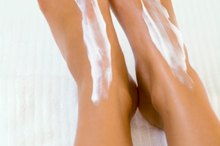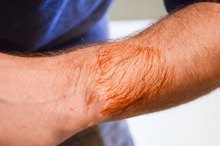How to Use Progesterone Cream for Fertility
Progesterone is a hormone that women naturally produce after ovulation 1. It is sometimes called the "warm" hormone, because it causes a rise in basal body temperature (i.e., temperature when the body is completely at rest). Using a progesterone cream can help increase fertility in women who have naturally low progesterone levels, because progesterone is involved in helping the uterus prepare to receive a fertilized egg 1.
Start using the cream after ovulation. If you start to use progesterone cream before you have ovulated, it can prevent ovulation---essentially the exact opposite of what you are trying to do 1. There are a number of ways to know when you are ovulating, but the simplest is to count fourteen days from the start of bleeding. Wait for a day or two after this time period to ensure that you have ovulated.
Progesterone Cream & Breastfeeding
Learn More
Apply between 100 and 200 milligrams of progesterone per day 1. If you are using a cream that is 3 1/3-percent progesterone (such as Natpro), this means that you will need to apply between 3 and 6 milliliters of cream per day 1.
Apply the cream twice a day. Split up whatever daily dosage you decide upon into two separate applications. This will provide optimal results, though the applications do not need to be of the exact same amount.
How to Use Hair Removal Cream on Tattoos
Learn More
Massage the cream thoroughly into your skin. The progesterone cream can be applied anywhere on your skin, but you should try to vary where you put it in so that you don't irritate your skin 1.
Use progesterone cream for 14 days (starting after ovulation) and then stop 1. Menstruation should occur within 1 or 2 days. If you begin to menstruate while using the cream, stop using it and then wait another 14 days before starting again. If you experience mild spotting, on the other hand, continue to use the cream.
Related Articles
References
- Progesterone Cream Guide
- Fugh-Berman A, Bythrow J. Bioidentical hormones for menopausal hormone therapy: variation on a theme. J Gen Intern Med. 2007;22(7):1030–1034. doi:10.1007/s11606-007-0141-4
- Han KH, Kim MK, Kim HS, Chung HH, Song YS. Protective Effect of Progesterone during Pregnancy against Ovarian Cancer. J Cancer Prev. 2013;18(2):113–122. doi:10.15430/JCP.2013.18.2.113
- Seifert-Klauss V, Prior JC. Progesterone and bone: actions promoting bone health in women. J Osteoporos. 2010;2010:845180. Published 2010 Oct 31. doi:10.4061/2010/845180
- Kaunitz AM, Manson JE. Management of Menopausal Symptoms. Obstet Gynecol. 2015;126(4):859–876. doi:10.1097/AOG.0000000000001058
- Regidor PA. Progesterone in Peri- and Postmenopause: A Review. Geburtshilfe Frauenheilkd. 2014;74(11):995–1002. doi:10.1055/s-0034-1383297
- Stevenson S, Thornton J. Effect of estrogens on skin aging and the potential role of SERMs. Clin Interv Aging. 2007;2(3):283–297. PMID: 18044179
- Elshafie MA, Ewies AA. Transdermal natural progesterone cream for postmenopausal women: inconsistent data and complex pharmacokinetics. J Obstet Gynaecol. 2007;27(7):655-9. doi:10.1080/01443610701582727
- Benster B, Carey A, Wadsworth F, Vashisht A, Domoney C, Studd J. A double-blind placebo-controlled study to evaluate the effect of progestelle progesterone cream on postmenopausal women. Menopause Int. 2009;15(2):63-9. doi:10.1258/mi.2009.009014
- Hermann AC, Nafziger AN, Victory J, Kulawy R, Rocci ML, Bertino JS. Over-the-counter progesterone cream produces significant drug exposure compared to a food and drug administration-approved oral progesterone product. J Clin Pharmacol. 2005;45(6):614-9. doi:10.1177/0091270005276621
- Holzer G, Riegler E, Hönigsmann H, Farokhnia S, Schmidt JB, Schmidt B. Effects and side-effects of 2% progesterone cream on the skin of peri- and postmenopausal women: results from a double-blind, vehicle-controlled, randomized study. Br J Dermatol. 2005;153(3):626-34. doi:10.1111/j.1365-2133.2005.06685.x
- Prior JC. Progesterone for Symptomatic Perimenopause Treatment - Progesterone politics, physiology and potential for perimenopause. Facts Views Vis Obgyn. 2011;3(2):109–120. PMID: 24753856
- Pinkerton JV, Pickar JH. Update on medical and regulatory issues pertaining to compounded and FDA-approved drugs, including hormone therapy. Menopause. 2016;23(2):215–223. doi:10.1097/GME.0000000000000523
- Ratner S, Ofri D. Menopause and hormone-replacement therapy: Part 2. Hormone-replacement therapy regimens. West J Med. 2001;175(1):32–34. doi:10.1136/ewjm.175.1.32
- Rzepecki AK, Murase JE, Juran R, Fabi SG, McLellan BN. Estrogen-deficient skin: The role of topical therapy. Int J Womens Dermatol. 2019;5(2):85–90. Published 2019 Mar 15. doi:10.1016/j.ijwd.2019.01.001
- Progesterone. National Center for Biotechnology Information. PubChem Database, CID=5994. 2019.
- Dalal PK, Agarwal M. Postmenopausal syndrome. Indian J Psychiatry. 2015;57(Suppl 2):S222–S232. doi:10.4103/0019-5545.161483
Writer Bio
Adam Cloe has been published in various scientific journals, including the "Journal of Biochemistry." He is currently a pathology resident at the University of Chicago. Cloe holds a Bachelor of Arts in biochemistry from Boston University, a M.D. from the University of Chicago and a Ph.D. in pathology from the University of Chicago.









